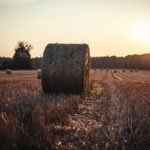
Giant bale of hay is evidence of hard work. Photo by Erik Witsoe of Unsplash
Make hay when the sun shines. That’s the mantra for the harvest season. It’s time to work hard, celebrate community, settle debts, and honor the sacrifice of the Corn King who gives his life for that of the community. That’s the subject of Episode 8 of Ritual Recipes, a podcast full of practical magic to nourish your inner life.
Centuries ago, July was called the hungry month because it was unlucky to gather fruits, dig potatoes, or in any other way begin the harvest until August 1st when the harvest season officially began. There was a lot to consider. The first reaping wouldn’t begin until the moon was in a waning phase, for that withdrawing energy would help dry the corn and grain, making it easier to cut and safer to store. Corn and grain, that’s what the first harvest of the season was all about.
A harvest was an organized, community effort. The farmer whose fields were being cut had to make sure that what wasn’t being harvested would be protected from being trampled – especially when libations of mead, beer, and wine were part of honoring the Corn King.
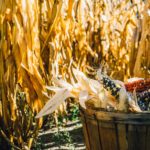
Field and basket of corn. Photo by Aaron Burden of Unsplash
More importantly, ritual reparation had to be made to Mother Earth for what was about to be taken from her. Her consort, the Corn King, would be cut down in the field to ensure the people would have food to last the winter and seed to plant in the spring.
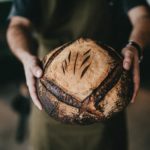
Round loaf of rustic bread / Photo by Nathan Dumlao of Unsplash
Even as the community recognized the necessary death of the Corn King, also called John Barleycorn, everyone understood that the Corn King was a willing participant because they knew, as did the Corn King, that come spring, he would rise again.
Once the cord had been harvested, it would be baked into the first loaf of bread of the season. The loaf symbolized the spirit of the Corn King as he began his long journey to the Underworld. People would eat the corn bread in honor of the Corn King and pour libations on the ground to cheer him on his long journey to the Underworld. Honoring the Corn King was a way of saying to Mother Earth: We recognize your loss. It is our loss, too.
The first harvest festival of the season was called Lammas, from the Anglo-Saxon word Hlafmas, or “loaf-mass.” The festival was also called Lugnasadh, named for the Celtic God Lugh.
Lammas was not only the first of the harvest fairs, it was the most popular. Young men, muscled from months of work in the fields, competed with each other by chopping logs, lifting stones, shooting arrows, and tossing lead weights and bales of hay, all in an effort to prove their physical prowess and, I imagine, to impress young women. In the mid-1700s, England prohibited such physical displays. They feared the unruly youth and their visible show of strength. What if the young folk realized their strength – especially as a group? What if the balance of power shifted? England banned anything to do with Scottish culture – no kilts, no bagpipes. No surprise, Scotland defied the edict and continued to wear kilts, play the bagpipes, and hold the competitions in secret. We know those competitions now as the Highland Games.
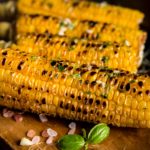
Ears of roasted corn / P:hoto by Dragne Marius of Unsplash
I’ve celebrated the festival of Lammas with public groups and private circles. Sometimes, I fashion refrigerated biscuit dough into the classic shape of a gingerbread man. Depending on the size of the group, I might make multiple small figures, or one large one. Sometimes, participants bring homemade cornbread to share. Sometimes, we simply have bowls of popcorn or corn chips. To feast on the symbol of the season is a key way to strengthen a sense of community.
In the old days, a strong sense of community was key to survival. Everyone helped everyone else. I think about my grandparents. Born in the 1800s, they were homesteaders on the Dakota Territory. The harvest meant that my grandfather, his sons, hired hands, and dinosaur-sized combines rented for a few days worked the fields well before sunrise and long into the night cutting corn and wheat, baling hay. They had to feed themselves and the cattle through winter. They had to work hard.
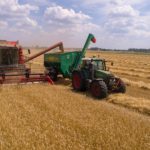
Threshing wheat with big equipment / Photo by Heiko Janowski of Unsplash
Back then, the harvest divided work along gender lines. Men in the fields. Women in the kitchens. Reputations were often made at a harvest. Which man could cut the most wheat? Bale the most hay? Which woman made the best coffee? Which woman cut her pies in four pieces, not six? Generosity was always noted.
On the other side of my family, August through early November marked the season when my Pennsylvania grandmother put up glistening jars of grape jelly, apple butter, and strawberry rhubarb jam –all from fruits and vegetables straight from her garden.
For both families, it was a time of hard work and abundance. With no television and only limited use of the radio, entertainment was like everything else—homemade. In Pennsylvania, they played cards. In South Dakota, they played the fiddle. Both families told stories.
In grammar school, I was always prepared to talk about how I spent my summer vacation. Storytelling came naturally. I’m sure it’s what led me to write romance novels. Just as I’m sure writing romance novels led me to officiate weddings, and creating wedding rituals led me to create a podcast about rituals. Destiny is a wide road.
In the world of my Celtic ancestors, August was also time when country fairs called people from the fields where they grew crops and from the open lands where they grazed herds. Known for harvests and festivals, August heralded a time of both hard work and its rewards.
August was also the time when those who owned land paid their taxes and others paid rent. In some parts of Scotland and Ireland, those who owed money anxiously eyed the debtors’ prison, praying to see a white glove. Should the aristocratic symbol be on view, the peasants would enjoy a grace period. They needn’t fear arrest for lack of funds to pay their debts. At least not in August.
Gloves were an important feature of the harvest season. A thoughtful landowner would provide gloves for those who worked to bring in his harvest.
I believe that we are influenced by our ancestral past, whether we realize it or not. One of the ways I connect with my past is by leading seasonal rituals at “Meg’s Inspirations,” a spiritual boutique in Manchester, Connecticut. For a recent Lammas ritual, Meg brought a basket of vegetables picked from her garden that morning and a bowl filled with popcorn. I added a bowl of gold coins – chocolate wrapped in gold foil. I also had a basket of big paper circles, the size of saucers. They represented coins, too.

Falcon trainer at Renaissance Faire / Photo by Gui Avelar of Unsplash
As the ritual began, I asked the participants to imagine they were approaching a harvest fair in Old England. You’re riding in a horse-drawn hay wagon, atop a mound of freshly mown gold. You see tents, games, and all manner of farm animals. You hear laughter that’s flirtatious, laughter that’s loud, laughter that’s bawdy. You hear songs – sweet songs, fighting songs, drinking songs. You smell apples – baked in pies and pressed as cider. You smell all manner of roasted meats, stews, and freshly baked breads. Imagine that you’re a farmer and that your harvest has yielded a bumper crop, far exceeding your expectations. You sold your crops at a good price. The money has given you power.

Girl in red dress holds chocolate coins covered in gold foil / Photo by Sharon McCutcheon of Unsplash
We passed out the paper coins. I asked everyone to think of their world today. Imagine receiving a windfall of prosperity and power – an inheritance, a winning lottery ticket, an Antiques Road Show genuine treasure. …Imagine how that would change your life.
Then I asked them to answer two questions and to write their answers on the big paper coin.
- What debt will you pay?
- What debt will you forgive?
Some people put pen to paper immediately. Others didn’t move, as though contemplating the answer to a question they’d never been asked…or a question they weren’t ready to answer.
When the time came, some people shared their answers out loud. Others chose silence. The specifics that were shared will remain private. What I can say is that, for most of us, the heaviest debts we carry, either because we owe them or because they are owned to us, are not financial.
One by one, we shredded the paper coins that contained our answers. They were for the writer’s eyes only. In exchange for the shredded paper coin, each person received a chocolate gold coin. Then we feasted on chocolate, popcorn, and apple cider.
What Debt Will You Pay?
My hope was that the symbol of prosperity would empower each of us settle our debts, whether that meant paying off credit cards or setting up a savings plan, …or looking at “other” debts. … Like the debt you have to your community. We all have such a debt. Your time is a like a gold coin. So is your expertise. So is your enthusiasm. Volunteer at a school or nursing home or soup kitchen or any number of local nonprofits. Support a cause you believe in. Spend your gold on and in your community.
Repaying a Debt
Sometimes, the concept of debt morphs into regrets. I’m mindful of an incident with a dear friend, the late Liz Aleshire. She was a forensic accountant. It was 2007 and my daughter, Laurie Neronha, a licensed esthetician, wanted to open her own skincare business. Liz sat down with Laurie multiple times and helped her craft a business plan she could take to the bank. Liz didn’t want to be paid for her expertise. You see, twelve years earlier, her son Nathan, an only child, died of bone cancer. Cancer. He was sixteen. Liz said she could never help Nathan…but she could help my daughter. Liz died the year after Laurie opened her business.
I’m happy to say that the business, Viriditas Beautiful Skin Therapies, in Providence, Rhode Island, got off to a solid start and, now with a staff of seven, continues to grow.
This past year, thanks to what my daughter learned from Liz, Laurie competed and won a $50,000 Goldman Sachs scholarship for small businesses.
A few years earlier, she became a certified instructor with Oncology Spa Solutions. Through this nationally recognized program, Laurie teaches other licensed estheticians how to care for and support the skin of clients who are currently being treated for cancer or who were treated for cancer in the past. The three-day training includes a half-day of highly supervised work with current and/or former cancer patients. I was present the first time Laurie taught the class. The emotional and spiritual rewards for both the patients and the estheticians were immeasurable. It wasn’t lost on me that Laurie’s work with cancer patients is a way of paying a debt to Liz.
One more thing. That day in 2007 when Laurie opened Viriditas, she hung a photo I had taken five years earlier of Laurie and Liz at the annual conference of the International Women’s Writing Guild. In the photo, they’re both smiling, heads touching, as though each knew they would have a forever connection.
So in this harvest season, whether you have a debt, a regret, or a desire to make the world a better place, share your knowledge, your skill, your expertise, your time, with someone who needs it.
What debt will you forgive?
That was the second question the ritual participants had to answer and it proved the more difficult. To my mind, to forgive a debt is to let it go. Let me explain.
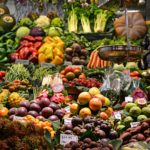
Bounty of fresh vegetables / Photo by ja-ma of Unsplash
The Lammas festival in August celebrates the first harvest, that of corn and grain. In September, the Autumn Equinox marks the second harvest, that of fruits – blueberries, grapes, apples, more depending on where you live. In October, the festival of Samhain, “the death of summer,” marks the final harvest, that of blood. This was the time when my South Dakota grandparents prepared the meat that would have to last them through the winter and early spring.
While it might not be obvious, the consideration of space was real. There was only one barn. Only one root cellar. Only one freezer. Any food still stored in the barn, the root cellar, the freezer had to go. Kept past its time, what was once intended to nourish would spoil, one way or another. So the food would be used immediately, or given away, or returned to the earth. A compost of sorts.
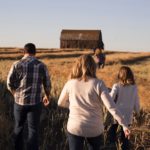
Farm family in field / Photo by Priscilla DuPreez of Unsplash
Holding on to a painful memory is like something that’s been in the barn, the root cellar, the freezer for too long. It’s like a debt you can’t forgive. And yet, if you don’t let it go, your heart will have no room for the gifts of the new harvest. I’ve been working on this one for years. I know it’s not easy. Ritual helps.
So, throughout this year’s harvest season, imagine your newfound prosperity and the power it brings. Again, I ask: What debt will you pay? What debt will you forgive?
The Harvest Moon

Full Moon / Photo by Andy Watkins of Unsplash
When I think of harvest, I immediately think of the Harvest Moon. That’s the full moon closest to the Autumnal Equinox. This year, 2018, the Equinox occurs on September 22, when the Sun enters the cardinal sign of Libra, marking the beginning of a new season. In the United States, the closest Full Moon will occur on September 24, making it the Harvest Moon. The Moon will be in the adventurous, impulsive, forceful, physical sign of Aries. The Sun will be in the diplomatic, indecisive, balance-seeking, intellectual sign of Libra. Our job, each of one of us, is to help the world blend those energies, the hot fire with the cool air.
A simple way to align with the energy of this Harvest Moon is a food ritual. It obviously works if you prepare the food yourself. It also works if you’re dining out. Remember that a ritual is a visible act performed with invisible intent. The invisible intent is to harmoniously blend the competing energies in the world, in your community, in your family, in your intimate relationships, and within yourself.
The visible act? Combine competing foods in an appetizing way…and eat them! Curried chicken with cucumbers, something red with something green – salsa and mint, cool season peas tossed with hot season sunflower seeds. You get the idea.
The tag line for Ritual Recipes is “a podcast full of practical magic to nourish your inner life.” The nourishing power of harvest rituals comes through hard work, community, power, debt and prosperity, sacrifice and forgiveness. As you enter the harvest season, may you find support for your efforts, a yield worth your efforts, and wisdom from of your efforts.
Ritual Recipes is a “side dish” of MoonRiverRituals.com (the mother website) where I’ve worked since 2012 as a certified Life-Cycle Celebrant to officiate more than 100 weddings, bless babies, perform vow renewals, conduct funerals and memorial services, and create seasonal rituals for private circles and public gatherings. For more information, please visit the website: MoonRiverRituals.com.
Before I step out of my virtual overalls, I want to give a big Thank You to Rob at Libsyn, the company that hosts Ritual Recipes. Thanks to Rob, my podcast is now on Amazon’s “Alexa” device. So, if you have such a device and you want to listen, just say, “Alexa, play Ritual Recipes podcast.” I wish you could have seen my husband’s face when I showed him how it works! That sweet man sat down and binge listened to every episode – all 7. If you know someone who has an Alexa device and would enjoy easy access to this podcast, please let them know. Thanks.
You can also find Ritual Recipes on Apple Podcasts, Spotify, Stitcher, iHeart Radio, wherever you feast on podcasts. If you liked the taste of this episode, please leave a review on the platform of your choice.
Thank you.
Mentioned in the podcast
This year, 2018, Highland Games will be held in Scotland, CT, on Sunday Oct 7. The games are held in various places all over the country. If you can’t get to Scotland, you can still connect with your clan.
Meg’s Inspirations, an inspirational and spiritual boutique in Manchester, Connecticut. This is where I hold the seasonal rituals.
Viriditas Beautiful Skin Therapies, the Providence, RI skincare business my daughter, Laurie Neronha, founded in 2007.
Libsyn, the company that hosts my podcast. Rob arranged to have the podcast on Amazon’s Alexa device. My husband and others who aren’t comfortable with technology now have an easy way to listen to Ritual Recipes.

